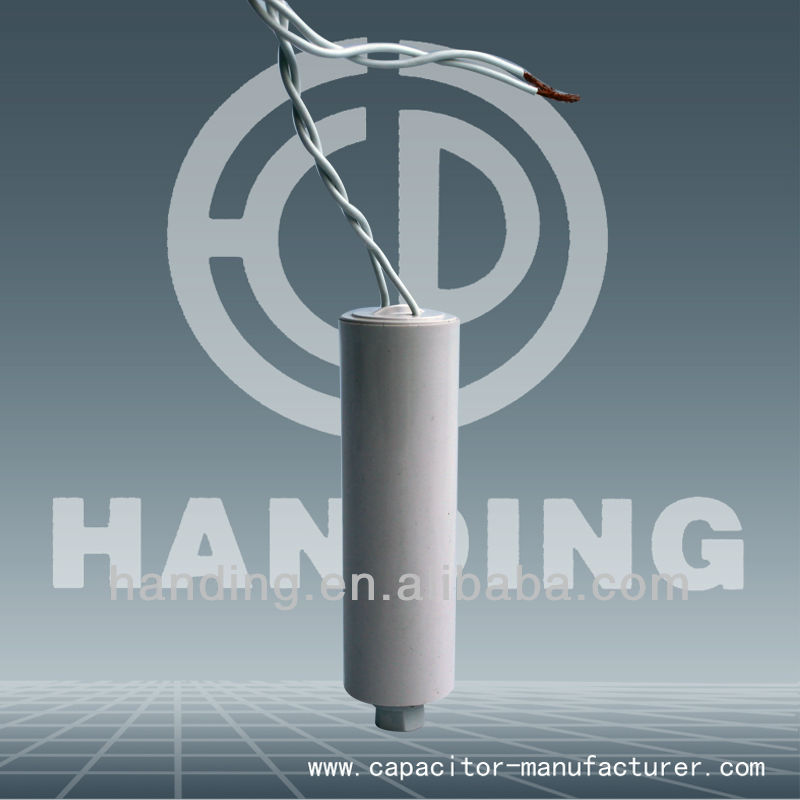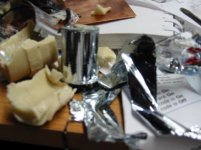http://www.ascapacitor.com/
Normally refers to the X386S. It appears the American distributed versions use steel terminals and are magnetic, the 'Shizuki' branded model from midorimeadows is non-magnetic and reported to be brass.
Normally refers to the X386S. It appears the American distributed versions use steel terminals and are magnetic, the 'Shizuki' branded model from midorimeadows is non-magnetic and reported to be brass.
Thanks. I just got done disecting a 3 dollar Chinese motor run. Inside the metal case was a nice plastic case. That was filled with what appears to be white wax. Buried inside the wax substance was a roll of very shiny foil looking material (very thin as well). It allmost looks like chrome peel. Any thoughts on these? Thanks, Jay
Attachments
cautions using motor run caps
thnks RDF for warning everyone of the dangers in using these
caps. there can be a considerable amount of leakage current to
the case and this makes their use as coupling caps problematic.
ie. for safety the case should be grounded but if you ground it
you will affect the upper freq response.
however this is not relevent when they are used in crossover networks which is where I prefer to use them.
thnks RDF for warning everyone of the dangers in using these
caps. there can be a considerable amount of leakage current to
the case and this makes their use as coupling caps problematic.
ie. for safety the case should be grounded but if you ground it
you will affect the upper freq response.
however this is not relevent when they are used in crossover networks which is where I prefer to use them.
One could just as well double insulate them rather than grounding them, either suspending them under the chassis or making a display case for them above it.
Grounding the case should not be much of an issue using them in power supply applications and as cathode bypasses - and if used on the low side to ground there should be no issue with parafeed either.
I don't think using them as interstage capacitors is the best way to use them, their large exterior surface area means that there will be considerable capacitance to the case or chassis ground if safety grounded.
Frankly I find in the case of the ASC types I use that they benefit strongly above the midrange by being shunted by any reasonable quality film cap, 20uF solens work well for example shunting 100uF X386 ASC's that I got from Midori Meadows. (recommended highly)
I think motor run caps may be slightly inductive, but have not so far tried to measure this.
Note that ASC does make ppio can caps expressly for audio applications, and these supposedly have lower inductance and possibly lower loss dielectrics.
Based on experience I have not found ungrounded cases to be a problem with just dc, the problem arises when there is a large ac component present in the signal on the capacitor as well. The X386 ASC I have measured had almost unmeasurable dc leakage at 400Vdc, but as I indicated that is not the case with AC necessarily and it will get worse the higher the frequency.
IMHO the cases should be grounded if they are somewhere where they can be easily touched and also if they are used as coupling capacitors otherwise they may pick up noise/rf if circuit impedances are high enough to allow this.
I don't think using them as interstage capacitors is the best way to use them, their large exterior surface area means that there will be considerable capacitance to the case or chassis ground if safety grounded.
Frankly I find in the case of the ASC types I use that they benefit strongly above the midrange by being shunted by any reasonable quality film cap, 20uF solens work well for example shunting 100uF X386 ASC's that I got from Midori Meadows. (recommended highly)
I think motor run caps may be slightly inductive, but have not so far tried to measure this.
Note that ASC does make ppio can caps expressly for audio applications, and these supposedly have lower inductance and possibly lower loss dielectrics.
Based on experience I have not found ungrounded cases to be a problem with just dc, the problem arises when there is a large ac component present in the signal on the capacitor as well. The X386 ASC I have measured had almost unmeasurable dc leakage at 400Vdc, but as I indicated that is not the case with AC necessarily and it will get worse the higher the frequency.
IMHO the cases should be grounded if they are somewhere where they can be easily touched and also if they are used as coupling capacitors otherwise they may pick up noise/rf if circuit impedances are high enough to allow this.
Hi,
I am going to use 97F series GE motor run caps in my amp upgrade. These cups are polyprops I believe.
Newark sells them. here is the link:
http://newark.com/NewarkWebCommerce...wark.com/product-details/text/CD121/7248.html
They are very expensive though.
I am going to use 97F series GE motor run caps in my amp upgrade. These cups are polyprops I believe.
Newark sells them. here is the link:
http://newark.com/NewarkWebCommerce...wark.com/product-details/text/CD121/7248.html
They are very expensive though.
Thanks. I just got done disecting a 3 dollar Chinese motor run. Inside the metal case was a nice plastic case. That was filled with what appears to be white wax. Buried inside the wax substance was a roll of very shiny foil looking material (very thin as well). It allmost looks like chrome peel. Any thoughts on these? Thanks, Jay
Nice to see a pic of the insides. This waxy content might be the reason why some oil-caps make a sound when you shake them (fluid oil shifting inside, seaside feeling) e.g. ASC, older MKVs, old Siemens mkp while others stay silent (GE, aerovox, philips...). I thought the silent types were totally filled with oil while the former weren't filled up to the top; a wax-filling might explain better why those stay mute.
Simon
jaymanaa said:....filled with what appears to be white wax. Buried inside the wax substance....
No oil at all?
measured leakage capacitance
just for curiosity sake I measured capacitance from the terminals
to the case of 30 some odd caps today.
I found a range of about 70pf to about 180 pf
these were G.E. AEROVOX , SANGAMO and MALLORY
with voltage ratings from 370v to 2500v
As you would expext the higher voltage rated devices had the lessor cap readings (from terminals to case).
i would agree that they are better used as power supply filters and bypass caps.
They do sound great in crossovers however.
just for curiosity sake I measured capacitance from the terminals
to the case of 30 some odd caps today.
I found a range of about 70pf to about 180 pf
these were G.E. AEROVOX , SANGAMO and MALLORY
with voltage ratings from 370v to 2500v
As you would expext the higher voltage rated devices had the lessor cap readings (from terminals to case).
i would agree that they are better used as power supply filters and bypass caps.
They do sound great in crossovers however.
Hi , i burned an interstage Xformer 1 year ago using a leaking NOS Sangamo 2uF/600v : At low voltage, on the ohmeter, it was perfect . With 150v ... 10mA leakage  I don't use these PIOs anymore in coupling ... polypros are more secure 🙂
I don't use these PIOs anymore in coupling ... polypros are more secure 🙂
 I don't use these PIOs anymore in coupling ... polypros are more secure 🙂
I don't use these PIOs anymore in coupling ... polypros are more secure 🙂Go to any electrical wholesaler and you can buy power-factor correction capacitors in incremental sizes to many uF. They are often used in fluorescent light fittings in offices and factories.

An externally hosted image should be here but it was not working when we last tested it.

I came across one of those once and I promptly put it into my power supply as the last leg.
It was better than anything I had at the time. If anything, it was a tad brittle at the top end, but no more than my old NAD Model 120 is 🙂 By comparison, I find motor runs a tad relaxed at the top end.
I feel that one of these PFC caps can offer a useful voicing option.
It was better than anything I had at the time. If anything, it was a tad brittle at the top end, but no more than my old NAD Model 120 is 🙂 By comparison, I find motor runs a tad relaxed at the top end.
I feel that one of these PFC caps can offer a useful voicing option.
I'm using a 2uf oil cap, bypassed with a 0.1uf teflon, as a parafeed cap. It's on the high side now and grounded to the chassis. The output impedence at the tube (resistively loaded) is about 4.2k. The transformer is about 12k, so 4.2//12 gives about 3.1k. If I assume 250nf for the oil cap to ground (I can't measure these values accurately, but it is less than 500nf), then I calculate the roll off to be around 200kHz. Is this an issue worth changing the the cap to the low side and isolating it?
Sheldon
Sheldon
Hi Sherman. I'ld be inclined to try it because:
- you can't be certain of the linearity of the leakage capacitance
- it swings a lot of voltage
- the impact at RF is uncertain (resonates against lead inductance, etc.?)
- as per above somewhere placement in the ground leg shorts or eliminates a circuit loop between output plate to ground
- I just like to tweak.
Incidentally, if it's the Russian Teflon the cap internals are isolated from outer shell by an air dielectric buffer. The cap hangs internally on the pins embedded in glass and should have a very 'clean' leakage capacitance.
- you can't be certain of the linearity of the leakage capacitance
- it swings a lot of voltage
- the impact at RF is uncertain (resonates against lead inductance, etc.?)
- as per above somewhere placement in the ground leg shorts or eliminates a circuit loop between output plate to ground
- I just like to tweak.
Incidentally, if it's the Russian Teflon the cap internals are isolated from outer shell by an air dielectric buffer. The cap hangs internally on the pins embedded in glass and should have a very 'clean' leakage capacitance.
The 0.1uf bypass cap is a Russian teflon, but it's not grounded anyway. It's inside the amp. The main "parafeed" cap is a 2uf motor run type from Mallory and is presently grounded. No problems noted so for. But I just got access to a Tek 454. Now I have to learn to use it. Looked up the manual and it's 300 pages - yikes!
Sheldon
Sheldon
- Status
- Not open for further replies.
- Home
- Amplifiers
- Tubes / Valves
- motor run caps in the output? good or bad idea?
